

The COVID-19 pandemic has had a devastating impact on U.S. retail sales. While some retailers have seen dramatic increases in their digital sales, others have lagged even there.
Among the hardest hit have been mall-based stores, where second-quarter earnings were down 256% year over year, according to Retail Metrics. Off-mall stores saw profits fall by just 0.6%.
Among those standalone stores, off-price stores typically see more traffic during recessionary times, and the coronavirus pandemic was no different. What was different was that off-price stores were hurt by consumers’ move to digital shopping.
A Bank of America Securities research note Thursday looked at three top U.S. retailers: Dollar General Corp. (NYSE: DG), Target Corp. (NYSE: TGT) and Walmart Inc. (NYSE: WMT). All have BofA Buy ratings, and all face softer sales heading into this year’s holiday season.
BofA analyst Robert Ohmes recently made a virtual visit to Dollar General and came away with five observations related to the company’s outlook. Ohmes was impressed by the expansion of Dollar General’s expansion into fresh and frozen food. The company expects to have completed the expansion at more than 14,000 of its 17,000 U.S. stores by the end of the year. The company’s self-distribution model for fresh and frozen foods should boost gross margins in fiscal 2022.
The company also expects to expand its non-consumable product offerings in about 5,400 stores by the end of the year. The expansion comes at the expense of phasing out apparel items. Dollar General is also ramping up its digital presence with “buy online, pick up in store” now available at virtually all stores and other digital initiatives available at a relative handful of stores.
Dollar General also is encouraging customers to buy more by introducing lower price store brands. Ohmes thinks that self-branded health/beauty aid products are a long-term growth opportunity for the company. He also sees an expanded produce section “represents an opportunity to grow the size of DG’s market and become a ‘fuller shop.'”
Shares traded Thursday morning at $204.04, in a 52-week range of $125.00 to $209.50. BofA’s price objective on the stock is $229 (implied gain of 12.2%), while the consensus estimate is $223.56.
Walmart and Target were discussed in a conference call with Ohmes and industry expert Dr. Kurt Jetta, founder and chairperson of sales and marketing analytics firm TABS. The subjects of the discussion were the food and consumer packaged goods (CPG) businesses.
Working in favor of both stores is their size and their massive customer bases, both in-store and online. Over time, these benefits are “likely [to] give them greater leverage in their relationships with CPG companies.” Both also are expected to continue working to improve profitability in their digital offerings of groceries and other categories of goods.
Walmart faces downside risk to BofA’s price objective from foreign exchange effects, pharmacy headwinds, food deflation and its long-term ability to continue gaining market share due primarily to its already massive footprint.
For some context, here’s a comment from Jetta on digital grocery sales during the pandemic:
Since eCommerce grocery has not succeeded in expanding the pool of buyers at a time when demand is expected to be greatest, it has become even clearer that this channel will never have the scale necessary to be profitable with the current business model. New, creative approaches are needed to address pricing and streamline the supply chain.
Walmart stock traded down slightly Thursday morning, at $135.99 in a 52-week range of $102.00 to $151.33. BofA’s $175 price objective on the stock compares with a $146.09 consensus estimate. BofA’s object is based on 32 times expected fiscal year 2022 earnings of $5.45. The multiple reflects positive same-store sales, along with increases in traffic, growth in the U.S. and Chinese digital markets, and “healthy” free cash flow generation. At Thursday’s trading price, the implied upside on Walmart stock is nearly 29%.
Target’s shares traded up about 0.4% to $151.63, in a 52-week range of $90.17 to $156.10. BofA’s price objective is also $175, yielding a potential upside of more than 15%. The consensus price target on the stock is $160.25. BofA bases its price objective on 25 times estimated fiscal 2022 adjusted earnings per share of $7.00. Ohmes expects long-term low-single-digit increases in same-store sales, mid-single-digit boosts in operating income and high-single-digit increases in earnings per share.
Thank you for reading! Have some feedback for us?
Contact the 24/7 Wall St. editorial team.



